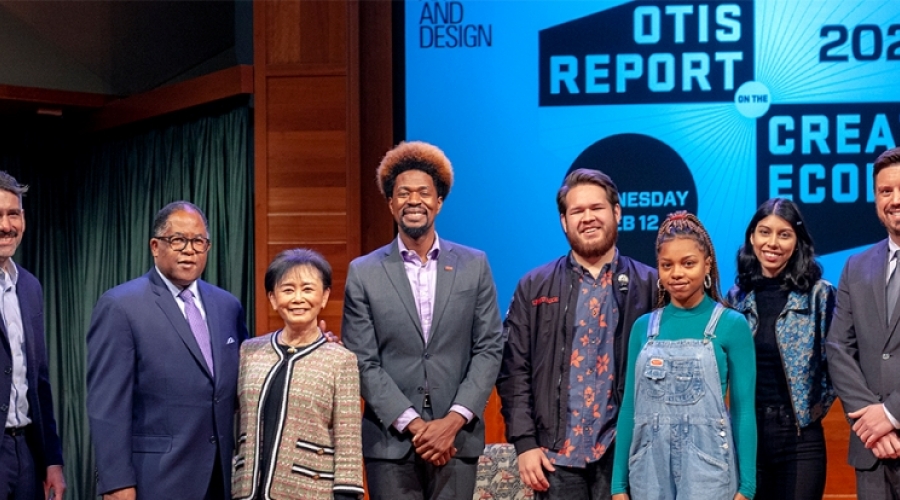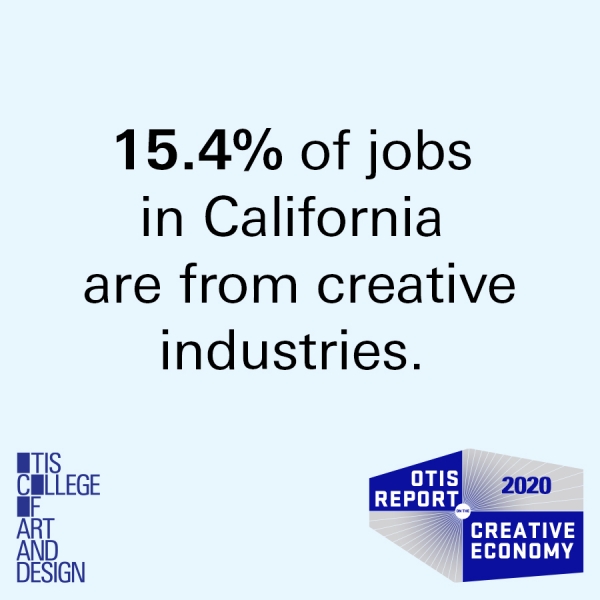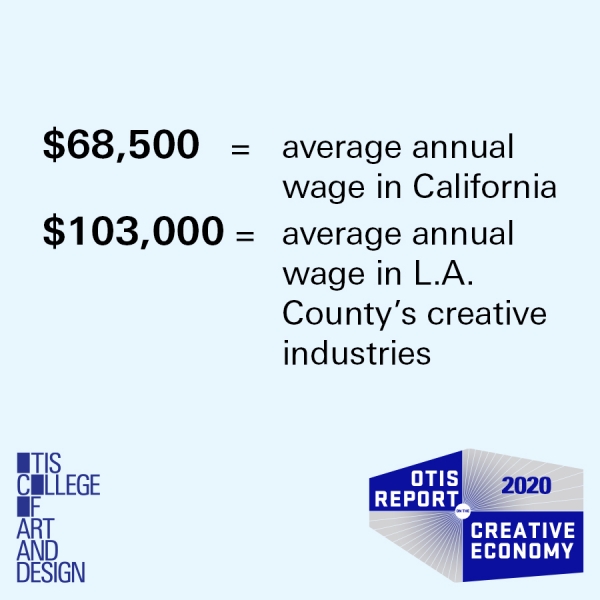
On Wednesday, February 12, at the Mark Taper Auditorium of the Los Angeles Central Library, Otis College of Art and Design released its findings for the 2020 Otis Report on the Creative Economy featuring remarks by L.A. County Supervisor Mark Ridley-Thomas and Amir Whitaker, staff attorney for ACLU of Southern California.
The 2020 Otis Report on the Creative Economy continues the College’s partnership with Beacon Economics to produce the Report, which highlights five creative industries and eight regional snapshots. New to the Otis Report this year are spotlights on two significant areas that include the growth of the gig economy and nontraditional work arrangements, as well as education in the arts as a critical training ground for the future of the creative economy and its leaders.
 “With nearly 1 out of 5 jobs in Los Angeles County supported by the creative economy, its importance as a source of job creation cannot be understated—it represents one of our greatest opportunities for the future,” said Supervisor Mark Ridley-Thomas. “As a policymaker data helps us turn information into insights and insights into action. On this front, this report has been deeply impactful.”
“With nearly 1 out of 5 jobs in Los Angeles County supported by the creative economy, its importance as a source of job creation cannot be understated—it represents one of our greatest opportunities for the future,” said Supervisor Mark Ridley-Thomas. “As a policymaker data helps us turn information into insights and insights into action. On this front, this report has been deeply impactful.”
The report, now in its 13th year, has become highly recognized throughout the state of California and throughout the world as a key indicator of creative economic activity for the world’s 5th-largest economy.
Significant findings in the 2020 Otis Report on the Creative Economy include:
- In total, direct and indirect employment generated by creative industries account for 16.3% of total employment in Los Angeles County; statewide in California, creative industries were responsible for 15.4% of total employment overall, directly and indirectly linked to creative fields.
- Los Angeles Country represents nearly 38% of all direct creative industry employment throughout the state of California. Also, roughly 1 in 5 jobs in L.A. County are generated directly or indirectly by multiplier effects due to creative economic activity.
- The Bay Area is the fastest-growing region in the state for the Creative Economy, with about 37% of salaried employment, and 23% of contract employment in creative industries.
- The number of art degrees awarded in Los Angeles County and California has increased at a rate of 17.8% and 20.1%, respectively, over the past five years.
- The state lags behind the rest of the country ranking 29th in a nationwide comparison of per capita funding on arts education in 2017.
- The Architecture and Related Services sector increased at a rate of 31% over the past five years statewide, outpacing the statewide Creative Economy average of 17% growth over a 5-year period.
- Entertainment and Digital Media is the largest-employing creative sector in California, accounting for 71% of the statewide Creative Economy workforce. In particular, the Sound Recording subsector grew at a rate of 22% over the past five years, vastly outperforming New York State’s 9% employment growth rate over the same time period.
- Fine Arts and Performing Arts is the fastest-growing sector in L.A. County’s Creative Economy, with an average wage of $92,000 that is substantially higher than the statewide average of $60,000.
- San Diego and Imperial Counties have 6% of wage and salary employment, and 7% of contract employment in California’s Creative Economy, meanwhile the Inland Empire has 3% and 5% of the State’s creative salaried and contract workers, respectively, in the creative workforce.
 The 2020 Otis Report on the Creative Economy is available to download as a PDF from a dedicated, interactive website, which also allows for a greater investigation into the report findings at this link. Support for the 2020 Otis Report on the Creative Economy has been provided by the City of Los Angeles Department of Cultural Affairs; Supervisor Mark Ridley-Thomas, Los Angeles County Board of Supervisors, Second District; Stuart Foundation; Endeavor Foundation; City National Bank; Gallagher; and Moss Adams.
The 2020 Otis Report on the Creative Economy is available to download as a PDF from a dedicated, interactive website, which also allows for a greater investigation into the report findings at this link. Support for the 2020 Otis Report on the Creative Economy has been provided by the City of Los Angeles Department of Cultural Affairs; Supervisor Mark Ridley-Thomas, Los Angeles County Board of Supervisors, Second District; Stuart Foundation; Endeavor Foundation; City National Bank; Gallagher; and Moss Adams.
Media partners include AIGA LA; Arts for LA; Arts Orange County; California Arts Council; Californians for the Arts; Create CA; California Alliance for Arts Education.
Main photo by Monica Nouwens. From left to right: Otis College’s Jeffrey Perkins, Supervisor Ridley-Thomas, Mei-Lee Ney, chair of Otis College’s Board of Trustees, Amir Whitaker of ACLU Southern California, Otis College student Juan Carlos Cruz, Foshay Learning Center student Alysha Boone, Otis College student Daisy Rosas, and Beacon Economics’ Adam Fowler.


